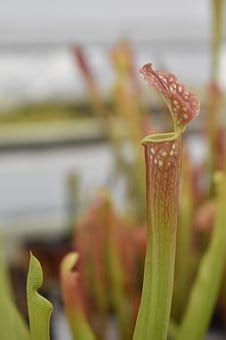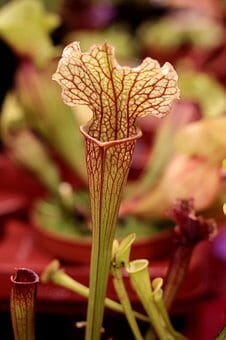Last Updated on January 8, 2023 by a Friendly Gardener
If you are intrigued by the carnivorous Venus Fly Trap, consider adopting a Pitcher plant. Native to several zones in the southern United States in the states of Mississippi and Louisiana where soil beds are nutrient-poor, these plants find food sources that are alternatives to the soil. Their appearance is unusual as they feature funnels that are disguised traps to catch insects and small animals.
The Pitcher plant secretes nectaras bait. When an insect enters the plant’s cup, digestive fluids turn it into a nutrient-filed soup for the plant to consume. Surprisingly, Pitcher plants are quite popular as indoor houseplants. Outdoor cultivation is more challenging.
Pitcher Plant Species

The Pitcher plant includes a total of five different genera:
- Nepenthes (Tropical) over 160 species
- Heliamphora more than 20 species
- Sarracenia (North American) 8 species
- Cephalotus (West Australian) – a single specie
- Darlingtonia – a single specie
The more well-known Pitcher plants number approximately 80 and are found under the genus names Darlingtonia, Sarracenia, and Nepenthes. Several of these are adaptable to outdoor cultivation while others are best grown indoors in a controlled environment.
Nepenthes are tropical and need tropical climate conditions. The Sarracenia purpurea, or Purple Pitcher plant, is very adaptable and can be cultivated in Canada. It does well in cooler climates.
The Yellow Pitcher plant aka Sarracenia flava is a native of Texas and the Florida bogs. The Sarracenia psittacine or Parrot Pitcher prefers warmer climates like the Yellow Pitcher plant.
The Darlingtonia californica is at home in northern California and southern Oregon. Many Pitcher plant species are problematic to cultivate. When selecting a Pitcher plant, find a species that can be cultivated in your area’s climate.
Pitcher Plant Care

The shape and characteristics of the Pitcher plant have developed because the plant cannot get sufficient nutrition from the soil bed in its native habitat. Native habitats are generally poor in nitrogen, so the plant traps insects to meet nutritional needs.
When cultivating outdoors, consider the location and the soil bed quality. Pitcher plants do not want rich soil although it should be well-draining. Soil should also be acidic.
Outdoor cultivation requires keeping the plants wet. Ideal conditions are boggy. Pond edges and bog gardens are perfect for Pitcher plant cultivation. Indoor Pitcher plants do well in any type of container including terrariums. The Pitcher plant needs full sunlight or partial shade for successful cultivation. With proper environmental conditions, this is a low-maintenance plant.
Soil
A highly acidic and peat-rich sandy soil bed is best. The soil bed must be nutrient-poor and well-draining. A mix of half sphagnum moss and half lava rock, perlite, or vermiculite works well. Another option is blending peaty soil, sand, and sphagnum moss.
Light
Pitcher plants require six to eight hours of bright indirect sun daily. If foliage turns yellow, this indicates too much sunlight. If the pitchers or foliage is droopy and floppy, there is a lack of sufficient light.
Water
These carnivorous plants like moisture and humidity. Water the plant if the soil bed is slightly dry. Water the soil bed but water from the top as well, so pitchers and foliage have access to moisture. Water thoroughly until water drains from the pot’s bottom. Pitcher plants must not be left to sit in water as they are susceptible to developing root rot.
Use collected rainwater, distilled water, or filtered water. Municipal tap water is often hard and heavy with mineral content. When using tap water, your plant will need flushing with distilled water at regular intervals to eliminate and build-up up minerals. Do not place your plant in air-conditioned rooms as they are generally too dry for these plants.
Humidity
The ideal humidity level for the Pitcher plant needs to be 50% or higher. By grouping it with other plants, immediate humidity will benefit. A pebble tray underneath the plant is an option as is a terrarium.
Temperature

The ideal cultivation temperature should measure between 55° and 95° Fahrenheit. When your plant enters dormancy, temperatures should measure below 60°F.
Most varieties of Pitcher plants do not tolerate the cold, so winter dormancy requires attentive care. A Pitcher plant can survive a brief cold snap. However, during the winter season, the plant should be moved indoors or protected. The Purple Pitcher plant is the hardiest species in this sense. In controlled environmental conditions such as those found in greenhouses, most varieties will manage well.
A drop in temperature in the winter is required for successful dormancy. Warmer temperatures signal that dormancy has ended. In extremely cold climates, mulch the plant base to protect the root system. If you are cultivating plants outdoors in water or a bog garden, break the ice regularly and keep water trays filled. The plants may need to be moved indoors.
Feeding
Feed your indoor Pitcher plant at the beginning of the growing season. Continue feeding monthly through to the fall. Orchid food is ideal for Pitcher plants.
Outdoor plants will not require feeding because these plants will trap insects to satisfy nutrient needs.
If a Pitcher plant turns yellow, it may not be harvesting enough insects. Apply a fertilizer of 1/8 teaspoon of acidic fertilizer in one quart of water. Avoid overfeeding.
Pruning
Leaves will drop naturally on outdoor plants. With die back, prune them off. New foliage will grow at the plant’s base. Outdoor plants will need some protection from ground freezing. Mound mulch at the plant’s rosette.
If your plant blooms, trim off any wilting flowers as well as yellow or brown foliage. Cut leaves below the yellow part.
Repotting
Repotting your Pitcher plant annually at the beginning of spring when the plant is still in dormancy. Remove the plant and soil placing it in a new container. Add in new soil to cover roots entirely. Water to remove any air pockets and add soil if necessary.
Pitcher Plant Propagation

Plant cuttings are the best option for propagation. The Pitcher plant produces both female and male flowers. They need to bloom simultaneously male pollen will arrive in the female flower. Propagation can also be accomplished using seeds but requires lots of time and a bit of luck.
Cut a climbing stalk with a basal rosette as a cutting. Stems below low-sitting leaves with buds are ideal. Count three nodes down and snip. Place the cutting in water. The water should cover the end and the cutting’s first node.
Use rainwater or distilled water. Place the glass jar with the cutting in a warm spot with bright light. Change water weekly. Within two weeks’ time, the stem should split and produce baby roots. When a minimum of six roots develop, transfer the cutting into a pot of sphagnum moss and keep it evenly moist. The plant will need roughly six months to develop into a typical Pitcher plant. Do observe the cutting for root rot or fungus.
Toxicity
Pitcher Plants are listed by the ASPCA as non-toxic to cats, dogs, and horses.
Diseases, Pests, and Problems
The main problems your Pitcher plant may encounter have to do with the environment. Plants at risk for outdoor freezing, need mulching. If the freeze arrives before the plant has entered dormancy, it can be lethal.
Being a bog plant, the Pitcher needs well-draining soil. Clay-based soil is not advisable as the plant may drown. Pesticides also constitute a danger to Pitcher plants.
Soil fertilization can encourage fungal disease in plants cultivated indoors. Fungal infections destroy the plant’s vascular system and root system. Always dilute the fertilizer to reduce the risk of infection.
Even if the Pitcher plant is carnivorous, there are pests that can bother it. These include spider mites. A moist plant will aid in prevention. Thrips can cause deformed foliage, and, mealybugs aphids, and leafhoppers, can literally destroy these plants. Organic Neem oil is a solution as are water rinses.
If your Pitcher plant develops black leaves, this indicates shock. Check your light, water, and feeding schedules and quantities.
Red foliage can be normal or signal a problem. New foliage tinged red is normal. Mature leaves that turn red indicate too little phosphorous or too much sunlight.
A Final Thought

The Pitcher plant is a fascinating carnivorous plant regardless of where it is cultivated. With proper environmental conditions, they are low maintenance and ask very little of owners. They will prove to be an intriguing addition to a terrarium, indoor home garden, or outdoor pond.

